Chris Baty's Blog, page 91
November 11, 2018
30 Covers, 30 Days: Day Eleven
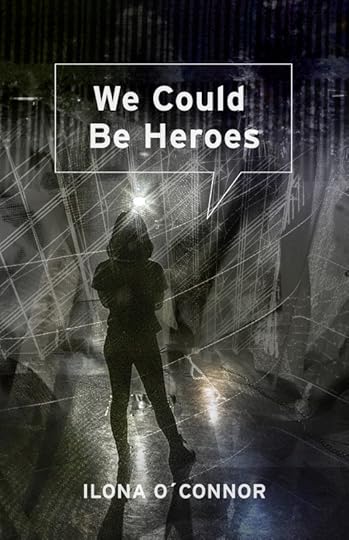
Every November, during National Novel Writing Month, thirty professional designers volunteer to create book cover art inspired by novels being written by aspiring authors from around the globe. Why? To encourage new, diverse voices, and help build a more creative world.
30 Covers, 30 Days is presented in partnership with designer and author Debbie Millman. Read more about these NaNoWriMo 2018 novels-in-progress, and the cover designers, below.
We Could Be HeroesA Young Adult novel being written this November by YWP participant Illona O’Connor in the United States.
How are you a superhero? This is the question Sierra Carter asks herself every single day of her life. Working for the Department of Undercover Operations is not an easy task, and it’s made harder by the fact that she isn’t allowed to tell anyone. Why were you chosen for this? Ever since Sierra’s parents died in an explosion, she’s lived at the D.U.O. base. Under the overview of Emily Cratchclaw, she and her friends (Winn, the genius; Fionna, the medic; and Jordan, the muscle) have worked on bigger-than-your-average-bear cases.What is going to happen next? Even though Sierra can’t let anyone know where she works, not even her boyfriend Isaac, she loves it. Every second is jam-packed with action, even through the teenage drama of her own and her friends’ lives. Fighting the Big Bads of our world that no one can know about? No problem. Bring it on.
Cover designer David Asari shared some sketches from the design process:

Stay tuned for new covers every day of the month!
If you’re interested in entering your novel to the 30 Covers, 30 Days program, check out the instructions here.
Cover Designed by David Hisaya Asari
David Hisaya Asari is a graphic designer and design educator, based in Oakland, California. He is an Associate Professor at California College of the Arts, focused on Graphic Design and information visualization; and leads a Japan study abroad course. David is President Emeritus of the San Francisco chapter of AIGA, the professional association for design. His word of the day: tsundoku.
Follow David online @davidasari.
November 10, 2018
30 Covers, 30 Days: Day Ten
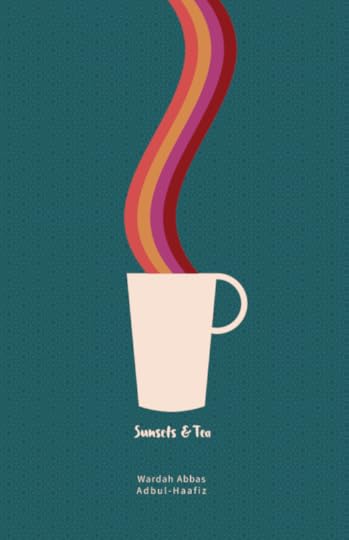
Every November, during National Novel Writing Month, thirty professional designers volunteer to create book cover art inspired by novels being written by aspiring authors from around the globe. Why? To encourage new, diverse voices, and help build a more creative world.
30 Covers, 30 Days is presented in partnership with designer and author Debbie Millman. Read more about these NaNoWriMo 2018 novels-in-progress, and the cover designers, below.
Sunsets and TeaA Women’s Fiction novel being written this November by NaNo participant Wardah Abbas Abdul-Haafiz in Nigeria.
Sunsets and Tea is a breathtaking story of four intimate city women set in modern day Nigeria. Brought together by childhood similarities, Aqilah, Amaya, Malika and Hodan are inseparable even where personal lives, struggle for survival, raising families and finding happiness are intricately woven into their individual pasts playing out around them. It is a heart rending novel of unforgivable pasts, bitter - sweet friendship and love that stands the test of fire - a remarkable achievement.
Cover designer Cookie Redding shared a photo of the cover design process, with a guest appearance from an assistant:
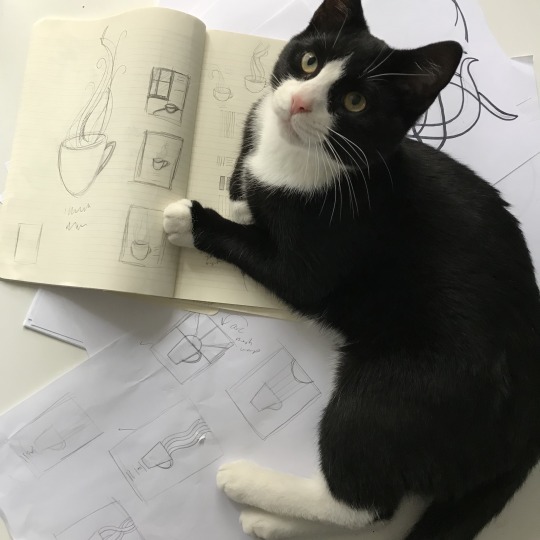
You can watch a video of Cookie’s design process on her Youtube channel.
Stay tuned for new covers every day of the month!
If you’re interested in entering your novel to the 30 Covers, 30 Days program, check out the instructions here.
Cover Designed by Cookie Redding
Cookie Redding is an artist and designer living in south central Pennsylvania. She works with a variety of materials and likes to incorporate them all into her work. She currently is also a professor of art and design and loves when students have their “ah-ha!” moment with their work.
You can find Cookie online @likesilovestudio and youtube.com/wordienerd.
November 9, 2018
How to Build a Story Around a Character (and Not the Other Way Around)

When you’re well into designing an enthralling plot, it’s easy to forget about what ultimately fuels the story: the characters! Today, writer K.R. Garcia shares her advice on how to develop realistic and resonant characters that will make any story shine:
Suddenly, it comes to you: a girl in a hot air balloon. The braids in her red hair have come free, and she’s standing at the edge of the basket, brandishing a vial of emerald liquid. The sky is peppered with milky white clouds, and the landscape below is a rocky wasteland of copper-grey.
You want to know who she is. But how can you build a story around just a fragment of an idea? Try building your story around a character!
As you might expect, it’s all about personality: the core of a character that drives their actions and, therefore, the plot. Personality branches into traits and desires.
Traits
What is your character like? They have positive and negative character traits—their advantages and disadvantages in the story. The conflict between these kinds of traits and their eventual resolution form the character arc.
I like starting out with five positive traits and four negative traits for a hero or vice versa for a villain. I’ve decided that the girl in the hot air balloon is a hero. Keeping in mind that traits are aspects of a character’s personality, not their physical features, professions, or skills, I can choose traits that fit the image I have of her. Let’s say her positive traits are adventurous, determined, clever, empathetic, and funny, and her negative traits are reckless, oversensitive, arrogant, and gullible.
Desires
What does your character want? For each of these desires, they should have an incentive and an obstacle in the way of them achieving that desire. These two things become, respectively, your character’s stake in the outcome of the story and the reasons it will not be easy for your character to get there.
One of your character’s desires will likely be stronger than the others, and this desire and its incentive and obstacle will come together to form the plot (the others can be subplots). If none of the desires stand out, that’s fine! Try looking at your list of desires. How can you connect them? What would happen if the worst outcome came out of an attempt to achieve one of those desires?
To start, I usually list ten desires for my characters. To find these, I can think about the events leading up to my idea fragment and imagine what could come next. For example, how did the girl in the balloon get there? I decide that she is trying to escape something. What is she escaping? I continue to ask questions and decide the answers until I have several desires to work with. I have to keep her character traits in mind so that none of her desires clash with them.
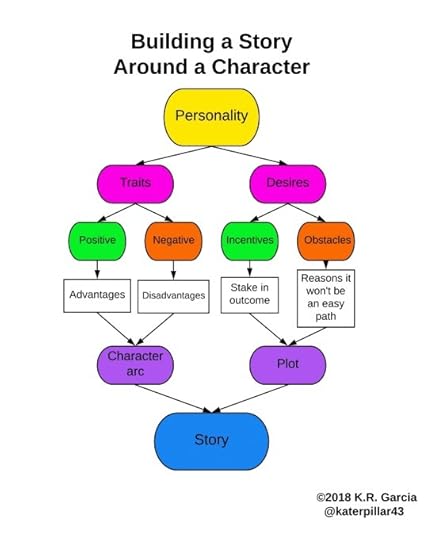
I’ll show you with my example:
Because she is empathetic, she desires to bring the cure for a disease home. She’s also clever, so she wants to escape the secret agents she stole it from. She’s adventurous, too, so she wants to control the hot air balloon.Beyond those desires, she has external incentives to succeed: her sister is sick, the agents mean her harm, and the hot air balloon is malfunctioning.
She still faces some obstacles: the cure will expire after three days, the secret agents won’t give up, and the hot air balloon is dropping towards the rocks below.
What’s the plot? My character goes on a quest to find a cure for her sister’s sickness, but the cure has to be used in three days, and the secret agents who created it will stop at nothing to find her.
This method works because characters are the lifeblood of the story. The plot is the mechanism that keeps the story going, but without any good characters to provide power, the mechanism couldn’t function. The character arc and plot come together to form the story.
By building the story around your characters, you can work your character seamlessly into the plot. Their stake in the outcome of the story will be strong and the threat of failure terrifying. But, most importantly, you’ll understand them better starting out. What better companion for a month of adventure than your own complex main character?

K.R. Garcia has been creating stories since before she could hold a pencil and has participated in nine NaNoWriMo and Camp NaNoWriMo events. An avid Agatha Christie reader, she writes mainly in the mystery and adventure genres. She coaches a class for young writers at her high school in Texas. When she is not writing, she enjoys classic rock, psychology, and music boxes. You can find her on Twitter at @katerpillar43.
Photo by Daniela Cuevas on Unsplash .
30 Covers, 30 Days: Day Nine
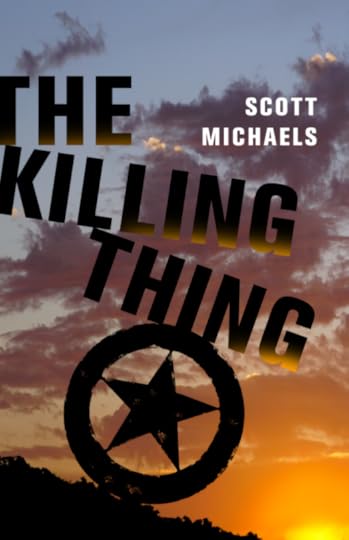
Every November, during National Novel Writing Month, thirty professional designers volunteer to create book cover art inspired by novels being written by aspiring authors from around the globe. Why? To encourage new, diverse voices, and help build a more creative world.
30 Covers, 30 Days is presented in partnership with designer and author Debbie Millman. Read more about these NaNoWriMo 2018 novels-in-progress, and the cover designers, below.
The Killing ThingA Thriller/Suspense novel being written this November by NaNo participant Scott Michaels in the United States.
Loneliness is the killing thing. Time, literally, is running out for Texas Ranger Lou Jackson after being diagnosed with lung cancer. His 30-year career is marked by a near obsessive quest to bring a killer to justice. He has sacrificed a marriage, his daughter is dead, his work was his only friend and the only world he has known is quickly passing him by. His killer has been silent for the past 10 years, but when another girl ends up dead and a message is left for Lou, he knows it’s his final chance. Now his life has come down to one choice…dying alone or with the only person he has embraced for the past 15 years.What if your only friend is the killer you’ve been hunting?
Stay tuned for new covers every day of the month!
If you’re interested in entering your novel to the 30 Covers, 30 Days program, check out the instructions here.
Cover Designed by Henry Sene Yee
Henry Sene Yee is a designer, photographer & illustrator. He started his career at Rolling Stone magazine. His first book publishing job was at Pantheon Books/Random House for the legendary Art Director, Louise Fili. He worked at St. Martin’s Press and was the Creative Director Deluxe of Picador Books. He has won numerous awards including: AIGA’s 50 Books / 50 Covers, The New York Art Directors’ Club GOLD Cube, The Type Directors’ Club, The Society of Illustrators, Print Magazine’s Regional Design Annual, and The New York Book Show. He can always be seen with a camera in one hand and a coffee in the other.
You can follow Henry on Twitter and Instagram @hsyee.
November 8, 2018
4 Essential Strategies for Distraction-Free Writing
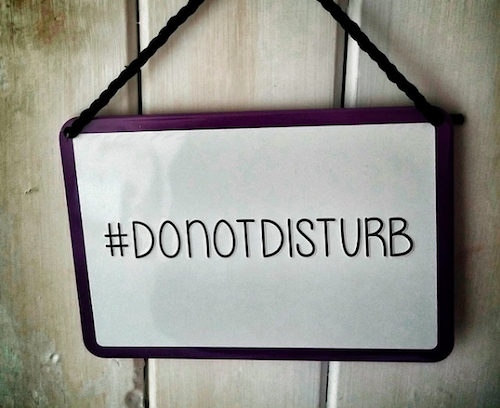
Every year, we’re lucky to have great sponsors for our nonprofit events. Today, we’re here to help you cut out the distractions in your life and focus on your novel with FocusMe, a NaNoWriMo 2018 sponsor:
So… here we are one week into NaNoWriMo. Today’s theme is Distraction Free Day, but we have put together four essential tips for you to have a Distraction Free month!
Writing your first novel is quite a challenge. You keep staring at that white void in your word processor, and you think: How on Earth am I ever going to get this done? It’s very tempting to just give in to your fears and doubts then, and go do something easier.
During NaNoWriMo, the goal is to write 1,667 words per day—almost 12,000 words per week. Are you on track? It’s a daunting and intimidating challenge for first-time novelists. But perfectly doable, if you have a good strategy that enables you to create a story without being distracted all the time. Just as an army general doesn’t go into battle without a solid plan, so should a writer have one before entering into the war of art.
Follow these strategies, and you’ll join the countless number of people that can proudly call themselves novelists:
Strategy #1: Write In The Morning“Why should it matter at what time of day I pick up my pen?”, you might ask.
Well, to be honest, a lot of writers have been successful despite each having their own different schedules and habits. Some write as soon as they get out of bed, others in the afternoon, while another might write in the depths of night. But that doesn’t mean there might not be an optimal time to get your writing done.

There has actually been scientific research into this. Studies have shown that people are most productive in the morning. This is linked to our circadian rhythm, which is our body’s internal biological clock. This rhythm causes our alertness and concentration to peak right after getting up, until about noon, after which it starts to slide down again. And an increased level of focus will cause you to be much less be distracted. Getting to bed on time will of course increase this strategy’s effectiveness.
Strategy #2: Write ConsistentlyRoutine, in an intelligent man, is a sign of ambition. A modern stoic knows that the surest way to discipline passion is to discipline time: decide what you want or ought to do during the day, then always do it at exactly the same moment every day, and passion will give you no trouble.
—W. H. Auden
Since you’re still reading this, we have already established that you are, in fact, intelligent. All we need now is to establish a routine, and all the signs of ambition will be present.
All joking aside, using a set routine really might be the single most important strategy you can use. In fact, it can even be said that it is a critical element of success. Writing consistently and implementing routine has many facets:
First of all, you have to write at a set time, and write every day. Even if you’re not going to follow Strategy #1, either because you have a job to go to, or you’re just really not a morning person, it’s still important to have a set time of day that’s dedicated to NaNoWriMo. Take your Google Calendar (or whatever it is you use to manage your time), and block off one or more hours per day for writing your story.
An second aspect of routine is that you set a minimum daily word count, and then make sure you get that amount done.
If you go about writing 500 words one day, 2000 words the next, and 300 words on Saturday, you’re setting yourself up for failure. Since you have to write 50,000 words during NaNoWriMo, that averages out to 1,667 words per day, or about 3-4 pages, which is perfectly doable on a daily basis. You don’t have to write a single word extra, but if you do, all the better.
Strategy #3: Take Breaks / Use the Pomodoro TechniqueIf you’re writing for hours on end without any rest, your mind is definitely going to get exhausted. As a result, you’re going to run out of steam, and whatever you put down on paper just isn’t going to be top notch, even if you do get to the required amount of words.
That’s why it’s useful, crucial even, to take breaks when writing. However, we’re not talking about the kind of breaks where you watch five episodes of your favorite TV show. Short, intermittent breaks where you just let your mind recover a bit are really useful in accomplishing this goal. A really good tactic to use breaks is the Pomodoro Technique.
With the Pomodoro Technique, you write for an allotted amount of focused writing (typically 25 minutes), after which you take a five minute break, and resume working. After the fourth time, you take a longer break of about fifteen to thirty minutes. If you are the type of writer who really gets into ‘the zone’, then you can always make the focus session longer, but you might want to extend the breaks a bit too.
That way, you can stay fresh and focused throughout your insane writing frenzy. Learn more about the Pomodoro technique here.

It used to be that writers made use of pen and paper. Then came the typewriter, which made things a bit easier. In the last few decades, we have these things called personal computers, which are even more convenient. However, there’s a big drawback to writing on a PC.
You see, you can’t use a pen, a piece of paper or a typewriter to:
Watch thousands of different movies and TV showsPlay an equal amount of addictive video gamesRead news sites and blogs (like you’re doing right now)Watch funny cat videos on YouTube (hey, I’m guilty of this too)Communicate with the rest of the world through social mediaSee the problem? That’s quite a list of distractions. Writers didn’t have all these luxuries in the past, and that probably made it a bit easier for them to get any work done. But no worries, because every problem has a solution.
You Wrimos are in luck! We’ve made our desktop app FocusMe free for all of you to use during NaNoWriMo, because we want to do everything in our power to help you succeed this November.
Here’s what you can expect from FocusMe:
✓ Automated Productivity—You can set a schedule that automatically starts your website/app blocking at the scheduled times you set. You’ll never “forget” to turn on your productivity software again.
✓ Time Tracking—See where your time is going - view how much time you spend and how many times you open each website or application. All data is stored securely on your PC, not in the cloud.
✓ A More Flexible Website Blocker—Most other productivity software only allow you to block sites. FocusMe has a Time Limiter feature to set a daily time limit for your list of “distracting, but occasionally needed sites”, like Facebook, YouTube, Gmail, etc.
✓ Take Better Breaks—FocusMe has customizable break and Pomodoro timers built in. If your 10 minute break usually turns into an hour break, or you just can’t pull yourself away from the computer for the entire day, then this is what you need.
✓ Impossible To Bypass—If your willpower gets weak, FocusMe has your back. You can either make it very difficult to disable your website/app blocks, or downright impossible (not even I can get by the Forced Focus mode).
✓ Advanced Blocking Capabilities—You can set allow rules and only block sites that you find distracting. For example, maybe you want to block most of reddit.com (sorry, Steve), but keep access to the parts you need for writing inspiration like reddit.com/r/writing/
My team and I are at the ready to make sure you get the most out of our software. If you have any questions or want help just shoot us a message or use our live chat service via focusme.com/support/
During NaNoWriMo, you’ll get top class support just like all our users do (read our reviews).
If you want to keep using FocusMe after NaNoWriMo, we offer all participants 30% off for life if you sign up by 15th December. And if you win, we’ll even increase that to 40% off. So if you decide to write a follow-up novel, we’ll help you out with that too. Sign up to use FocusMe for free during NaNoWriMo here.
Whether you use FocusMe in November or not, we wish all Wrimos the very best of luck to complete your novels and keep focused!
P.S. Want to read more writing and productivity tips? Check out our blog.
Jon Rumens is the Creator of FocusMe, an app that’s dedicated to make the world (including yourself) more productive. As a former procrastinator, he has made it his mission to increase November’s worldwide novel output.
30 Covers, 30 Days: Day 8

Every November, during National Novel Writing Month, thirty professional designers volunteer to create book cover art inspired by novels being written by aspiring authors from around the globe. Why? To encourage new, diverse voices, and help build a more creative world.
30 Covers, 30 Days is presented in partnership with designer and author Debbie Millman. Read more about these NaNoWriMo 2018 novels-in-progress, and the cover designers, below.
Red Riding, P.I.
A Mystery novel being written this November by NaNo participant J. Monsen in the United States.
Life is never dull for a private detective in the city; not when a vampire staked in the back, a fairy kidnapping, and a mysterious glass shoe all add up to just another Monday. But lately, Red Riding has found the gumshoe business a little harder than usual; like someone’s painted a target onto the back of her trench coat. Maybe it’s the organized crime racket that’s been hot on her heels, or the politicians cracking down on innocent Spooks. Maybe it’s the handsome professor with a bad attitude and suspiciously good aim. Or maybe it’s Red’s own secrets finally catching up to her, like the transformation every full moon that she can’t escape. Or maybe it’s just bad luck and a big mouth. One thing’s for sure, if Red wants to survive solving mysteries in the Big Bad City, she’s got her work cut out for her.
Cover designer Kevin Perry shared what Red Riding, P.I. would look like as a physical book:
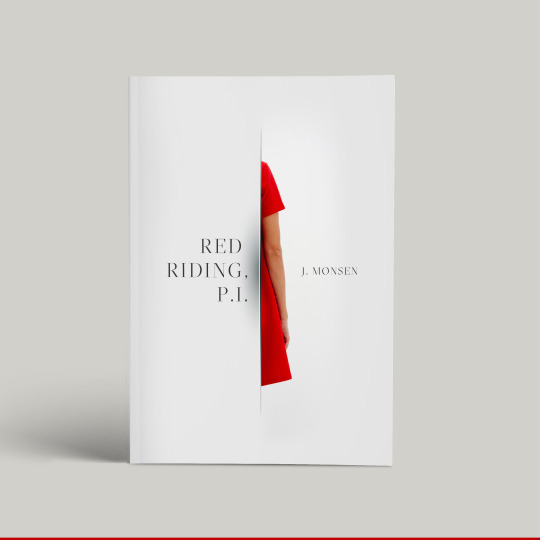
Stay tuned for new covers every day of the month!
If you’re interested in entering your novel to the 30 Covers, 30 Days program, check out the instructions here.
Cover Designed by Kevin Perry
Kevin Perry is a designer, educator and organizational leader with over 15 years of agency experience. He currently oversees talent and operations at Struck, an internationally acclaimed creative agency whose clients include Nickelodeon, Universal Studios, McDonald’s and Jack in the Box. Kevin draws from a unique blend of design philosophy and business strategy to significantly impact organizational behaviors and cultures. As a leader, Kevin helps companies be more purposeful and effective through a people-centric approach. As an orchestrator, he seeks to create an environment where everyone can thrive. He brings fresh insight to every engagement where success is measured in terms of values, not merely profit and loss. Kevin speaks around the country and teaches at the University of Utah. His work has been recognized by some of the industry’s most respected organizations and publications including AIGA and Print Magazine. In 2014 he was selected by Graphic Design USA as one of the “People to Watch”. Kevin is the cofounder of Salt Lake Design Week and the ReVinylize project and has held a number of roles with AIGA, the professional association for design, where he most recently served on the national board of directors.
You can follow Kevin online @kevinperry.
November 7, 2018
“Writing is more like gardening, where the work is hard and...
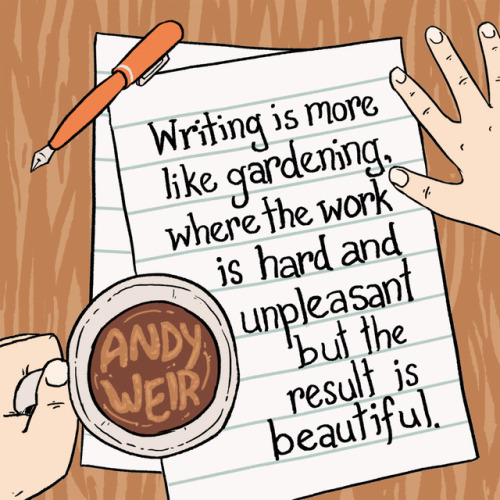
“Writing is more like gardening, where the work is hard and unpleasant but the result is beautiful.” —Andy Weir
Our amazingly multi-talented Customer Service Captain, Wesley Sueker, has illustrated quotes from this year’s Pep Talks! Check out Wesley’s other work on DeviantArt, and read the rest of Andy Weir’s pep talk here.
30 Covers, 30 Days 2018: Day Seven
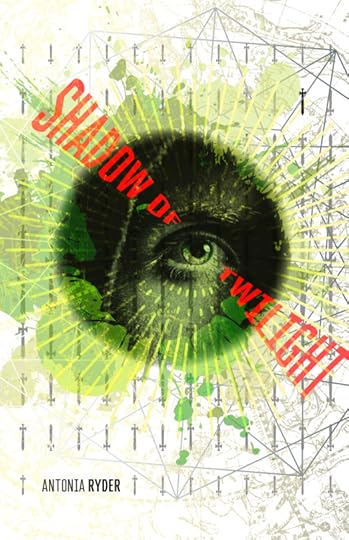
Every November, during National Novel Writing Month, thirty professional designers volunteer to create book cover art inspired by novels being written by aspiring authors from around the globe. Why? To encourage new, diverse voices, and help build a more creative world.
30 Covers, 30 Days is presented in partnership with designer and author Debbie Millman. Read more about these NaNoWriMo 2018 novels-in-progress, and the cover designers, below.
Shadow of TwilightA Fantasy novel being written this November by NaNo participant Antonia Ryder in Canada.
Sixteen-year-old Rin Phyra has never spoken in his life, and because of it, feels like he’s useless and ignored by most of his village. So when the village elder sends a special request for him to attend a meeting, Rin is eager to play whatever part he’s offered to help his village.
The occasion is the princess’s eighteenth birthday. For generations, the villages of the kingdom have taken turns providing the most powerful fairies for the royal daughters so they can obtain magic. This year, it is Rin’s village’s honour, and he is entrusted with the fairy’s sphere to give to the princess. It’s an echo of a hundred years ago, and just as her ancestor, Princess Corrine is destined to stop the Shadow King’s awakening.
But when the fairy escapes her bindings for Rin instead and has to contract with him to save her life, he’s sure he’s ruined everything - after all, he’s not a princess, and his green eyes bar the usage of magic. So he has to accompany the princess to the goddess herself to fix his blunder.
Only the goddess does not correct his mistake. She gives him a sword to banish the Shadow and summons a mysterious swordsman named Twilight to teach him to fight.
Now history itself is about to turn on its head.
Cover designer Alberto Rigau had this to share about the design process:
Antonia, when I first read your brief, I have to admit, I was a bit overwhelmed (in a good sense). There was so much happening: great visuals, a complex storyline, mysterious characters, a mythological setting; and all of it experienced through a young and up-and-coming main character. You had my attention.
I began thinking about Rin’s first hand experience… maybe making a mostly white cover with a bit of color (graphic or photographic) to metaphorically represent Rin’s waking… but the approach felt too plain for such a layered abstract. What if I could add this? Then that? I ended with a cover that I think mimics the abstract in character, hopefully provoking in possible readers that same curiosity that your words provoked in me.
I realize the profession of design is more on the ‘less is more, flat design’ these days, but this story seems to need more character, more depth, more layers… a ‘more is more’ approach.Is it too much? Is it graphically overdone? I hope your final novel will live to validate it. I hope you enjoy it.
If you’re interested in entering your novel to the 30 Covers, 30 Days program, check out the instructions here.
Stay tuned for new covers every day of the month!
Cover Designed by Alberto Rigau
Alberto freelances from San Juan, Puerto Rico, collaborating with clients in the planning and execution of design focused business strategies. With an academic focus on design, anthropology and photography, he crafts brands, exhibits, way-finding systems, publications and architectural collaborations of an interpretative nature. Alberto is a graduate of the Masters in Graphic Design program at NC State University’s College of Design, a Poynter Institute Visual Journalism Fellow and an alum of the S.I. Newhouse School of Public Communications at Syracuse University. Today he serves as a board member of AIGA’s Design Educators Steering Committee.
You can follow Alberto online @ajrigau.
November 6, 2018
Pro Tips from a NaNo Coach: 3 Ways to Reach Your Writing Goals
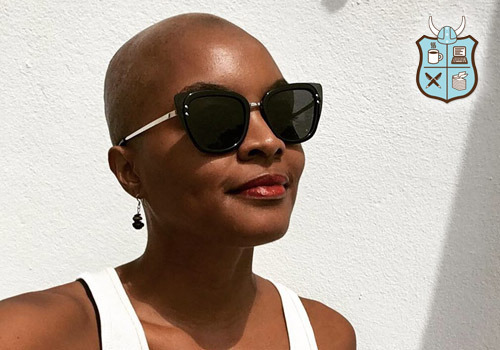
NaNoWriMo can seem like a daunting task sometimes, for NaNo newbies and veterans alike. Fortunately, author Alyssa Cole is here to share her advice on how to overcome some of NaNo’s obstacles:
Hello Wrimos! Welcome to the first week of NaNoWriMo. Many of you are veterans, swarming into the writing breach once more, and many of you are first time NaNoers and possibly first time writers! Whether this is old hat or brand new for you, this is a huge undertaking and you should be proud of yourself for giving it a go! Writing a book is an exhausting, stressful venture whenever you do it, but trying to complete a draft in thirty days can be downright harrowing. In order to help get this #NaNo party started write (heh), I’m going to offer you three of my best tips on getting organized and reaching your goal!
1. Write everywhere.Do you commute by public transportation? Whip out the notes function on your phone or your handy writer’s notebook if longhand is your thing and get words in on the go. Have a lunch break? Try to fit in a writing sprint. Carting your kids back and forth? Bust out that laptop in the car as you wait. If you’re down with transcription, record your voice as you do your daily chores. You see my point—take as many opportunities as are within the realm of reason to up your word count. Chip away throughout the day, even if it’s fifty words here and there, to take some of the pressure off as you work
2. Affirmations/VisualizationI can’t lie to you, things will get tough at some point in the process. You’ll hit a wall, burn out, or simply get lost in the weeds. It’s important to remember that all of these setbacks are part of the writing process. This can be done, even when it seems impossible (because frankly, it seems impossible every time)! Place post it notes or alarms with the reminder “I can do this.” Say those words out loud when you’re feeling down. Visualize submitting your 50K (or more!) draft on November 30 and seeing that WINNER! screen pop up. Yes, I know it sounds corny, but hey, writers talk to themselves an visualize seemingly impossible feats all the time, so it’s not much different than an average day for us.
3. Plan out your writing times.If you, like certain writers who shall remain unnamed, have a problem with setting realistic writing goals, use tools that will help you break your goals down into manageable pieces. I like using Pacemaker, which is a writing goal planner—you input the information on your project (type/length/etc.) and it provides you with a customizable plan. You choose your own strategy: starting off small and building up to larger word counts, knocking out a huge chunk earlier in the project, writing the same amount every day, or random word counts. Pacemaker provides you with a daily goal (and you can input days that you can work more or less, e.g., less on workdays, more on weekends), and you update daily, allowing you to keep track of your work and see how far you’ve come and how much you have to go. It also automatically redistributes the amount of work you need to do when you don’t hit your goal, so you aren’t faced with that “oh my god, I missed one day of writing, this is impossible now” sense of doom. You can view your progress in a plot or calendar—overall, it makes any project seem doable by laying out exactly what it will take instead of hopeful (or destructive) guesses.
I’ll let you all in on something: NaNoWriMo changed my life. Back in 2011, I was one of those people who always started projects but never completed things. I kept thinking “One day, I’ll finish a book!”, but had no game plan for making that happen. Enter NaNoWriMo. I had about three chapters of a story that I wanted to see to completion, and I told myself that I would finish it that November. I made time to write every day. I mostly pantsed it, but I made sure to get words down whenever I could. And at the end of that November, I was a NaNoWriMo winner. That book, Eagle’s Heart, was my very first published novel, which came out in 2014.
In November of 2013, I has an idea for a novella—a secret ring of African-American spies during the Civil War, a Black heroine with an eidetic memory, and the charming Scottish Pinkerton she joins forces with. I knew this book was a long shot, but the idea wouldn’t leave me, so I told myself I would get it out of my system during NaNoWriMo. I won in 2013, too, and that book went on to become An Extraordinary Union, which came out in 2017, won the RT Reviewers Choice Book of the Year and is the ALA RUSA selection for Best Romance for 2018.
I’m not saying that every NaNo project will lead to success—but I’m saying that if not for the spirit of community and purpose provided by National Novel Writing Month, who knows when I would have finished that first novel? Who knows if An Extraordinary Union would have come to fruition? What you’re working on will change your life, too, no matter the outcome, because you will have pledged to devote yourself to you craft and even if you don’t hit 50K, you’ll have the beginnings of what will eventually become a book! That’s a win-win if I’ve ever heard one. Good luck to all of you!
Alyssa Cole is an award-winning author of historical, contemporary, and SFF romance. Her Civil War-set espionage romance An Extraordinary Union was chosen as the RT Reviewers’ Choice Award’s Best Book of 2017 and the American Library Association’s RUSA Best Romance for 2018. She’s contributed to publications including Bustle, Shondaland, The Toast, Vulture, RT Book Reviews, and Heroes and Heartbreakers, and her books have received critical acclaim from The New York Times, Library Journal, BuzzFeed, Kirkus, Booklist, Jezebel, Vulture, Book Riot, Entertainment Weekly, and various other outlets. When she’s not working, she can usually be found watching anime with her husband or wrangling their menagerie of animals.
30 Covers, 30 Days 2018: Day Six
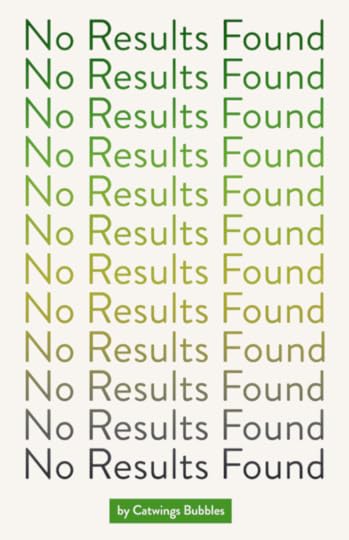
Every November, during National Novel Writing Month, thirty professional designers volunteer to create book cover art inspired by novels being written by aspiring authors from around the globe. Why? To encourage new, diverse voices, and help build a more creative world.
30 Covers, 30 Days is presented in partnership with designer and author Debbie Millman. Read more about these NaNoWriMo 2018 novels-in-progress, and the cover designers, below.
No Results FoundAn LGBT+ novel being written this November by YWP participant Catwings Bubbles in the United States.
The Soulmate Test is a long and rigorous process that takes years to finish, but no one has every been matched with someone other than their true love. Emilie is ready to take the first test that matches her with thousands of people before whittling the options down to one. But out of every single available person in the registry, Emilie can’t be matched with any of them.
It must be a mistake. Right?
If you’re interested in entering your novel to the 30 Covers, 30 Days program, check out the instructions here.
Stay tuned for new covers every day of the month!\
Cover Designed by Kelly Knaga
Kelly Knaga is a Chicago based artist and designer. She loves shapes, colors, and making things.
You can find Kelly online at kellyknaga.com or on Twitter and Instagram @kellyknaga.
Chris Baty's Blog
- Chris Baty's profile
- 63 followers



